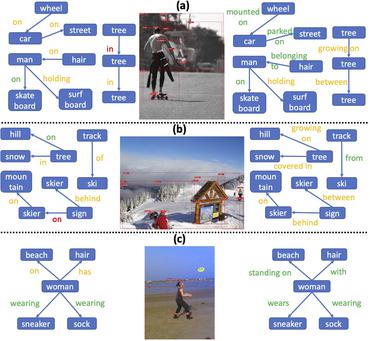Search Results for author: Xingchen Li
Found 12 papers, 4 papers with code
A Joint Model for Graph-based Chinese Dependency Parsing
no code implementations • CCL 2020 • Xingchen Li, Mingtong Liu, Yujie Zhang, Jinan Xu, Yufeng Chen
The experimental results on the Penn Chinese treebank (CTB5) show that our proposed joint model improved by 0. 38% on dependency parsing than the model of Yan et al. (2019).
CalibFormer: A Transformer-based Automatic LiDAR-Camera Calibration Network
no code implementations • 26 Nov 2023 • Yuxuan Xiao, Yao Li, Chengzhen Meng, Xingchen Li, Jianmin Ji, Yanyong Zhang
The fusion of LiDARs and cameras has been increasingly adopted in autonomous driving for perception tasks.
EdgeCalib: Multi-Frame Weighted Edge Features for Automatic Targetless LiDAR-Camera Calibration
1 code implementation • 25 Oct 2023 • Xingchen Li, Yifan Duan, Beibei Wang, Haojie Ren, Guoliang You, Yu Sheng, Jianmin Ji, Yanyong Zhang
The edge features, which are prevalent in various environments, are aligned in both images and point clouds to determine the extrinsic parameters.
USTC FLICAR: A Sensors Fusion Dataset of LiDAR-Inertial-Camera for Heavy-duty Autonomous Aerial Work Robots
no code implementations • 4 Apr 2023 • ZiMing Wang, Yujiang Liu, Yifan Duan, Xingchen Li, Xinran Zhang, Jianmin Ji, Erbao Dong, Yanyong Zhang
In this paper, we present the USTC FLICAR Dataset, which is dedicated to the development of simultaneous localization and mapping and precise 3D reconstruction of the workspace for heavy-duty autonomous aerial work robots.
Decomposed Prototype Learning for Few-Shot Scene Graph Generation
no code implementations • 20 Mar 2023 • Xingchen Li, Long Chen, Guikun Chen, Yinfu Feng, Yi Yang, Jun Xiao
To this end, we propose a novel Decomposed Prototype Learning (DPL).
Standoff Tracking Using DNN-Based MPC with Implementation on FPGA
no code implementations • 21 Dec 2022 • Fei Dong, Xingchen Li, Keyou You, Shiji Song
This work studies the standoff tracking problem to drive an unmanned aerial vehicle (UAV) to slide on a desired circle over a moving target at a constant height.
Integrating Object-aware and Interaction-aware Knowledge for Weakly Supervised Scene Graph Generation
1 code implementation • 3 Aug 2022 • Xingchen Li, Long Chen, Wenbo Ma, Yi Yang, Jun Xiao
However, we argue that most existing WSSGG works only focus on object-consistency, which means the grounded regions should have the same object category label as text entities.
Rethinking the Evaluation of Unbiased Scene Graph Generation
no code implementations • 3 Aug 2022 • Xingchen Li, Long Chen, Jian Shao, Shaoning Xiao, Songyang Zhang, Jun Xiao
Current Scene Graph Generation (SGG) methods tend to predict frequent predicate categories and fail to recognize rare ones due to the severe imbalanced distribution of predicates.
A deep learning method based on patchwise training for reconstructing temperature field
no code implementations • 26 Jan 2022 • Xingwen Peng, Xingchen Li, Zhiqiang Gong, Xiaoyu Zhao, Wen Yao
To solve the problem, this work proposes a novel deep learning method based on patchwise training to reconstruct the temperature field of electronic equipment accurately from limited observation.
Unified Style Transfer
1 code implementation • 20 Oct 2021 • Guanjie Huang, Hongjian He, Xiang Li, Xingchen Li, Ziang Liu
Currently, it is hard to compare and evaluate different style transfer algorithms due to chaotic definitions of style and the absence of agreed objective validation methods in the study of style transfer.
An Infrared Communication System based on Handstand Pendulum
no code implementations • 9 Sep 2020 • Xingchen Li, Changlu Li, Yun Wang, Mengqi Lei
In this system, 940nm infrared light is mainly used for audio signal transmission, and an handstand pendulum based on PID is used to control the angle and stability of infrared light emission.
Hierarchical Fashion Graph Network for Personalized Outfit Recommendation
1 code implementation • 26 May 2020 • Xingchen Li, Xiang Wang, Xiangnan He, Long Chen, Jun Xiao, Tat-Seng Chua
Fashion outfit recommendation has attracted increasing attentions from online shopping services and fashion communities. Distinct from other scenarios (e. g., social networking or content sharing) which recommend a single item (e. g., a friend or picture) to a user, outfit recommendation predicts user preference on a set of well-matched fashion items. Hence, performing high-quality personalized outfit recommendation should satisfy two requirements -- 1) the nice compatibility of fashion items and 2) the consistence with user preference.





